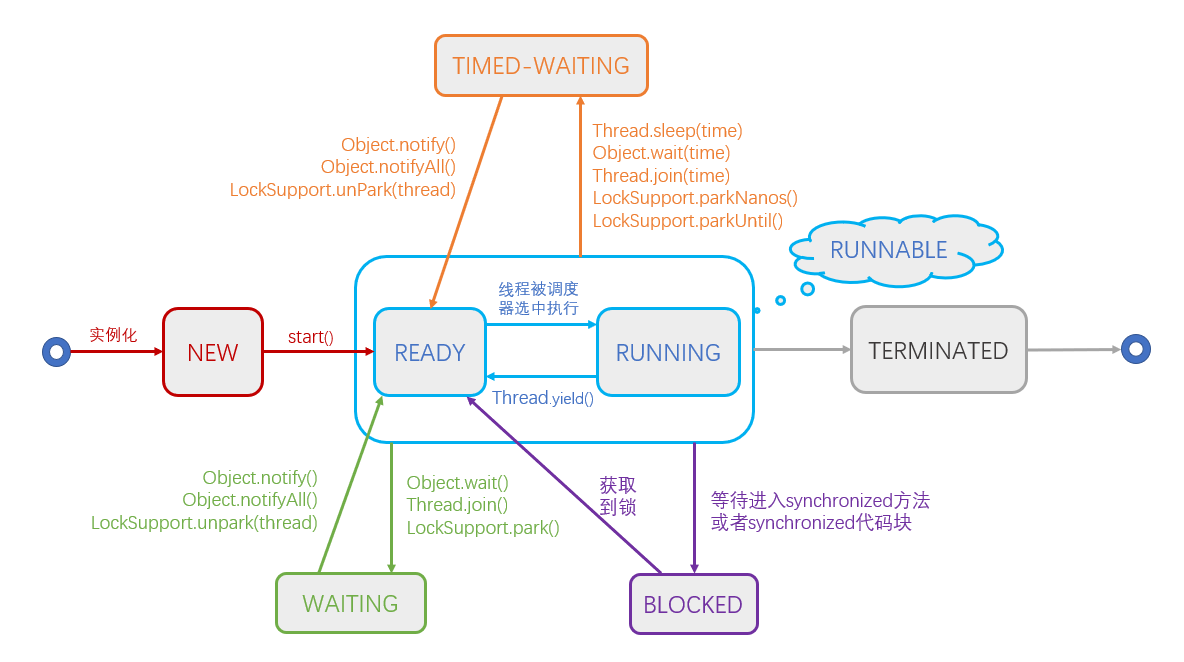多线程-线程状态
线程的6种状态
1 | public enum State { |
NEW线程被创建出来了,但是还没有start()RUNNABLE可运行状态,这个状态比较特殊,我在图中把这个状态拆分成了两部分:一部分是READY,顾名思义是准备状态,另一部分是RUNNING,即运行状态READY准备状态,只能说明你有资格运行,单只要调度程序没有调度到你,你就永远是准备状态RUNNING运行状态,线程调度程序从可运行池中选择一个线程作为当前线程时线程所处的状态
BLOCKED阻塞状态是线程阻塞在进入synchronized关键字修饰的方法或代码块(获取锁)时的状态WAITING等待状态的线程不会被分配CPU执行时间,它们要等待被显式地唤醒,否则会处于无限期等待的状态TIMED_WAITING超时等待状态的线程不会被分配CPU执行时间,不过无须无限期等待被其他线程显示地唤醒,在达到一定时间后它们会自动唤醒。这是和上面的WAITING状态的区别TERMINATED终止状态,顾名思义,线程执行结束了
线程状态切换函数
Thread.sleep、Thread.yeild、Object.wait、Thread.join、Object.notify/notifyAll、LockSupport.park/unpark/parkNanos/parkUtil
Thread.sleep(time):当前线程调用此方法,顾名思义,就是让当前线程进入TIMED_WAITING状态,睡眠固定的时间(但是不释放对象锁),到点后自动唤醒,进入准备状态。主要作用是给其他线程执行机会
Thread.yield():当前线程调用此方法,放弃获取的CPU时间片,但不释放锁资源,由运行状态变为准备状态,让OS再次选择线程。实际中无法保证yield()达到让步目的,因为让步的线程还有可能被线程调度程序再次选中。它跟 sleep方法的区别在于不能指定暂停多少时间
Object.wait():当前线程调用对象的wait()方法,当前线程释放对象锁,进入WAITING 状态。依靠notify()/notifyAll()来唤醒;而wait(time)方法的主要区别是进入 TIMED_WAITING 状态,到达时间后,自动唤醒
Object.notify/notifyAll:notify()唤醒在此对象监视器上等待的单个线程,选择是任意性的。notifyAll()唤醒在此对象监视器上等待的所有线程
Thread.join():当前线程里调用其它线程t的join()方法,当前线程进入WAITING状态,当前线程不会释放已经持有的对象锁。线程t执行完毕,当前线程进入RUNNABLE状态。而join(time)方法的主要区别是当前线程进入 TIMED_WAITING 状态,到达时间后,进入RUNNABLE状态
LockSupport.park():当前线程进入 WAITING 状态,需要通过LockSupport.unpark(thread)来唤醒
LockSupport.parkNanos(nanos)/parkUntil(deadlines):当前线程进入TIMED_WAITING状态,需要通过``LockSupport.unpark(thread)`来唤醒
相比与wait方法,LockSupport不需要获得锁就可以让线程进入 WAITING 或者 TIMED_WAITING 状态
当然了,还有个 BLOCKED 状态,涉及到 synchronized关键字,由于这块也是面试经常会问到的,下一篇我会全面剖析一下synchronized
